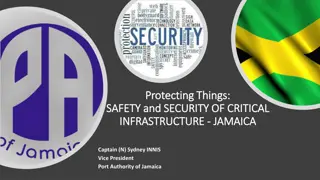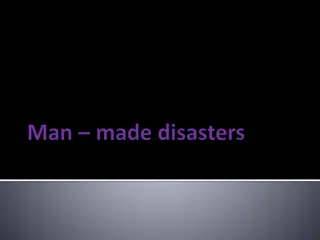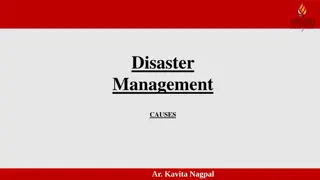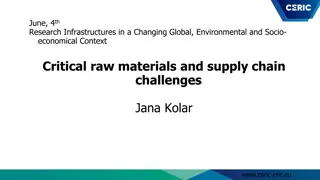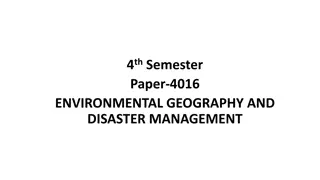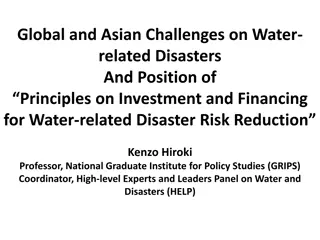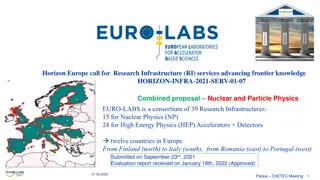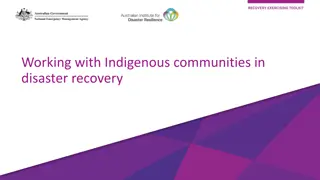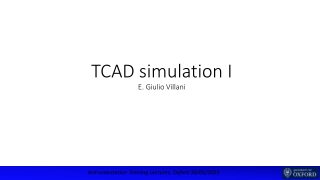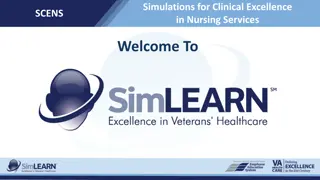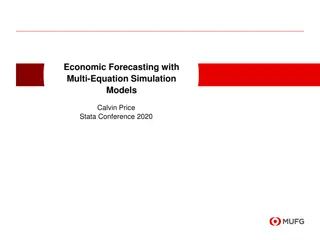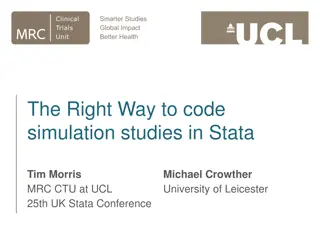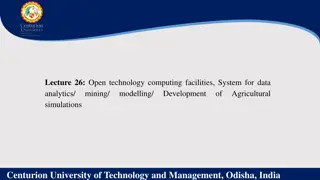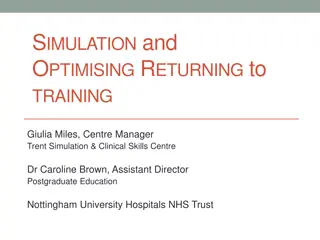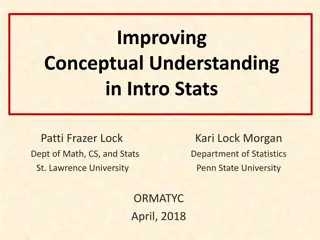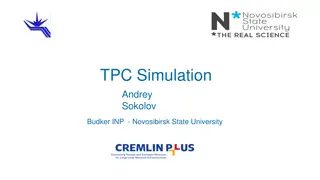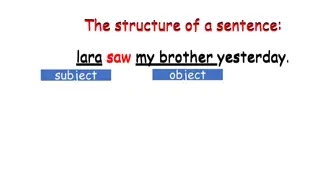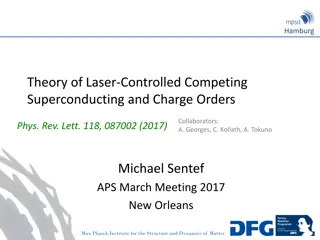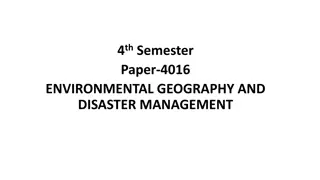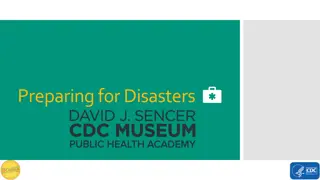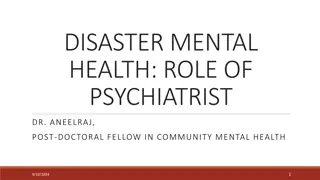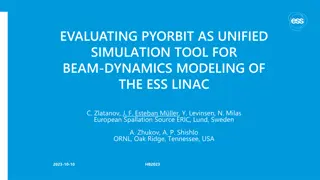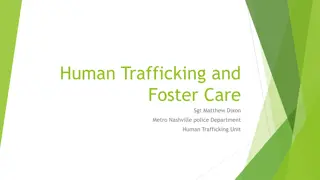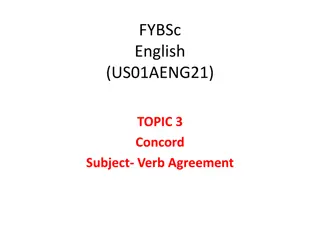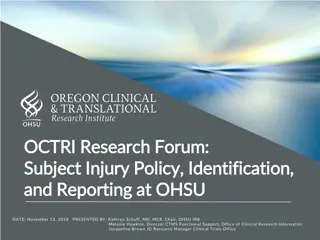Simulation Framework for Controlled Critical Infrastructures Subject to Natural Disasters
This research project focuses on developing a Simulation Framework, utilizing the I2Sim toolbox, to assess the impact of natural disasters on critical infrastructures. The framework includes creating a simulated disaster test environment, designing testing procedures to analyze disaster effects, developing heuristic controllers for resource allocation, and formulating disaster policies for various scenarios. The platform, I2Sim, allows the analysis of interconnected infrastructures under operational constraints, with specific emphasis on Energy and Water resources within a typical community setting.
- Simulation Framework
- Critical Infrastructures
- Natural Disasters
- Disaster Resilience
- Infrastructure Interdependency
Download Presentation

Please find below an Image/Link to download the presentation.
The content on the website is provided AS IS for your information and personal use only. It may not be sold, licensed, or shared on other websites without obtaining consent from the author. Download presentation by click this link. If you encounter any issues during the download, it is possible that the publisher has removed the file from their server.
E N D
Presentation Transcript
A Simulation Framework for Controlled Critical Infrastrucutures Subject to Natural Disasters Amir Mohammed, Craig J Ramlal, Arvind Singh, Sean Rocke and Daniel Goitia Amir Mohammed The University of the West Indies, Trinidad Craig J. Ramlal The University of the West Indies, Trinidad Arvind Singh The University of the West Indies, Trinidad Sean Rocke The University of the West Indies, Trinidad Daniel Goitia The University of the West Indies, Trinidad IConETech-2020, Faculty of Engineering, The UWI, St. Augustine, Trinidad and Tobago
OBJECTIVES Development of a Simulation Framework to evaluate natural disasters imposed on CI's (critical infrastructures) using the I2Sim (Infrastructure Interdependecy Simulator) toolbox. The development of a simulated disaster test environment. Development of appropriate testing procedures (inputs) to analyse the effects of natural disasters on CI's. Development of heuristic controllers for controlling resource allocation in disaster scenarios (Energy, Water, People). The generation of disaster policies for different disaster scenarios. IConETech-2020, Faculty of Engineering, The UWI, St. Augustine, Trinidad and Tobago
INTRODUCTION TO I2SIM A platform which allows the analysis of the interdependent behaviour of interconnected infractructures (cells) under different operational constraints. Each cell within I2Sim consists of five (5) Physical Modes (PMs) which model the input output relationships for different operational scenarios. These PMs are defined by the Human Resource Table (HRT) for each cell. IConETech-2020, Faculty of Engineering, The UWI, St. Augustine, Trinidad and Tobago
MODEL OVERVIEW (ELEMENTS) PRODUCTION CELLS (Energy and Water) The Energy and Water resources are the two main inputs into the system RESIDENCE HEALTH CENTRES/HOSPITAL DEATH The metric used to determine the best possible outcome for a given disaster scenario. Recorded as an iterative collection of failed treatments. IConETech-2020, Faculty of Engineering, The UWI, St. Augustine, Trinidad and Tobago
THE MODEL (A TYPICAL COMMUNITY) Figure 1: Model Outline IConETech-2020, Faculty of Engineering, The UWI, St. Augustine, Trinidad and Tobago
TESTING PROCEDURE (ENERGY) The testing procedures conducted on the energy production cell involved the exhaustive evaluation of the effect on the model for each combination of PM values. Rotation of Loads (Rotating Black Out) The rotating black out was a specific situation in which loads were turned on and off for a specific period of time. At each simulation iteration, unique combination of PMs were simulated with the controller reporting the best combination of rotation of loads. IConETech-2020, Faculty of Engineering, The UWI, St. Augustine, Trinidad and Tobago
CONTROL STRATEGY (ENERGY) Figure 2: Heuristic Controller for Energy Production Cell IConETech-2020, Faculty of Engineering, The UWI, St. Augustine, Trinidad and Tobago
TESTING PROCEDURE (WATER) One Pump Damaged - All combinations which involved only one pump being damaged Two Pumps Damaged - All combinations which involved only one pump undamaged Movement of People MOP and Truck Bourne Supply (TBS) MOP was implemented as a relief method in which sickly from an overcrowded health unit was moved to another health unit that was not overcrowded The TBS strategy was a relief method in which water resources were delivered to cells anywhere in the model. IConETech-2020, Faculty of Engineering, The UWI, St. Augustine, Trinidad and Tobago
CONTROL STRATEGY WATER Figure 3: Heuristic Controller for Water Production Cell IConETech-2020, Faculty of Engineering, The UWI, St. Augustine, Trinidad and Tobago
RESULTS Energy Testing Table 1: Rotation of Loads for PM 2 Active Loads Tested Combina tions A B C D E F A B C D E G A B C D F G A B C E F G A B D E F G A C D E F G B C D E F G Water /L 320500 439000 500000 481500 590000 591750 588000 Death Recorded 200 250 200 50 0 0 65 No No Not needed Not Needed MOP change Change 0 0 0 IConETech-2020, Faculty of Engineering, The UWI, St. Augustine, Trinidad and Tobago
RESULTS Energy Testing Table 2: Rotation of Loads for PM 4 Tested Active Loads Combinations A B E F A B E G A B F G A E F G B E FG Water / L 279 000 289 000 315 000 401 500 403 500 Death Recorded 450 500 500 415 365 MOP 325 425 190 365 190 IConETech-2020, Faculty of Engineering, The UWI, St. Augustine, Trinidad and Tobago
RESULTS Water Testing Table 3: Comparison of Results for when one pump was damaged Pump Three Damaged Pump One Damaged Pump Two Damaged Physical Mode of Damaged Pump Sickly TD MOP Sickly TD MOP Sickly TD MOP 0 0 0 - - - 0 0 0 0 0 0 0 0 0 0 - - 0 - - 1 2 3 4 5 0 0 0 0 0 0 0 50 150 250 300 100 375 500 50 75 200 25 125 200 75 200 250 250 IConETech-2020, Faculty of Engineering, The UWI, St. Augustine, Trinidad and Tobago
RESULTS Water Testing Table 4: Comparison of Results for when two pumps was damaged Physical Mode Physical Mode Pump 1 Undamaged Simulated with PA Death Recorded with PA - - - - 0 0 0 225 Pump 2 Pump 3 Sickly TR TD PA 1 1 2 2 1 2 5 5 1 2 1 2 4 3 3 4 0 0 0 0 0 0 0 0 - - - - 50 50 375 150 400 675 50 50 300 100 50 50 75 50 350 625 TBS MOP TBS TBS IConETech-2020, Faculty of Engineering, The UWI, St. Augustine, Trinidad and Tobago
ENERGY PRODUCTION POLICIES It is evident that Loads (E F G) which contain a water pump must be given highest priority as a result of cascaded failure seen by dependent cells. Results show that when cells are off there is still a minimum operational capacity achievable if water is provided to the cell. In situations where less loads can be turned on (PM4) the combination of loads which generated the lowest number of death when on were A E F G and B E F G. However the MOP can be adopted to reduce the deaths. Restoration of energy services should be prioritized based on the following table to achieve the most optimal impact. IConETech-2020, Faculty of Engineering, The UWI, St. Augustine, Trinidad and Tobago
ENERGY PRODUCTION POLICIES Table 5: The Inferred Prioritization of Loads based Load Dependencies Number of Affected Cells Load Off Affected Loads Priority Affected Cells R6, R2, R3, Hospital, Health Centre 2, Pump 2 R5, R1, Health Centre 1, Pump 1 R7, R 4, Pump 3 R3, Hospital R4 R2, Health Centre 2 R1, Health Centre 1 1 F F, B, C 6 2 3 3 4 5 5 E G C D B A E, A G, D C D B A 4 3 2 1 2 2 IConETech-2020, Faculty of Engineering, The UWI, St. Augustine, Trinidad and Tobago
WATER PRODUCTION POLICIES It was evident from the test scenarios that Pump 3 was the most critical pump followed by Pump 2 and then Pump 3. Therefore in the event of a disaster, the restoration for these pumps should be prioritized in that order. Relief Methods such as MOP/TBS should therefore be allocated giving preference to the dependent cells in conjunction with the pump prioritization previously stated in order to achieve the most optimal response. IConETech-2020, Faculty of Engineering, The UWI, St. Augustine, Trinidad and Tobago
CONCLUSION In this study, a simulation and control framework was developed for evaluating response decision policies for natural disaster scenarios aiming at reducing the loss of life. The framework targets water and electricity utilities and produces recommendations for the best possible decision to reduce the casualty count for each disaster scenario. The framework has put forward a testing approach which aims at looking at all possible disaster situations which will be difficult to investigate under real life conditions. IConETech-2020, Faculty of Engineering, The UWI, St. Augustine, Trinidad and Tobago
REFERENCES Sowedi Masaba, David N Mungai, Moses Isabirye, and Haroonah Nsubuga. Implementation of landslide disaster risk reduction policy in Uganda. International Journal of Disaster Risk Reduction, 2017. [14]M. Choksi and M. A. Zaveri, Multiobjective based resource allocationand scheduling for postdisaster management using iot, Wireless Commu-nications and Mobile Computing, vol. 2019, 2019. S. Basu, S. Roy, S. Bandyopadhyay, and S. D. Bit, A utility drivenpost disaster emergency resource allocation system using dtn, IEEETransactions on Systems, Man, and Cybernetics: Systems, 2018. [9]Julia Crowley. A measurement of the effectiveness and efficiency of pre- disaster debris management plans. Waste Management, 62:262 273, 2017. IConETech-2020, Faculty of Engineering, The UWI, St. Augustine, Trinidad and Tobago
THANK YOU ! IConETech-2020, Faculty of Engineering, The UWI, St. Augustine, Trinidad and Tobago





